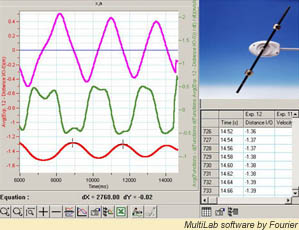How Probes Work
 The probeware hardware consists of probes that use sensors to convert a physical property into an electrical signal. This signal requires some form of interface electronics to make it readable either by a computer or by the interface itself. Some probes have the interface built in. The probe or interface connects to the computer using a USB or Bluetooth connection. A wide variety of probes are used in education, including temperature, light, dissolved oxygen, and carbon dioxide, to name just a few.
The probeware hardware consists of probes that use sensors to convert a physical property into an electrical signal. This signal requires some form of interface electronics to make it readable either by a computer or by the interface itself. Some probes have the interface built in. The probe or interface connects to the computer using a USB or Bluetooth connection. A wide variety of probes are used in education, including temperature, light, dissolved oxygen, and carbon dioxide, to name just a few.
Software used with probes displays the data in "real time" often as a number, dial, table or graph. This allows learners to quickly associate the physical change with the way the representation changes. Some software can also analyse the data and filter out extraneous factors such as background noise.
Software also frequently includes calibration support which uses an equation to relate the "raw" values it reads from the sensor to a physical value such as temperature reported in degrees Celsius. The process of calibration adjusts this equation to increase its accuracy. This is necessary because not all sensors are identical and most change their sensitivity or "drift" over time making recalibration necessary. Two-point calibration usually involves placing the probe in several known values. For example to calibrate a temperature probe, the probe might be placed in freezing and boiling water because those temperatures are known. All subsequent reading are rendered relative to those values.
Robert Tinker, The Concord Consortium
